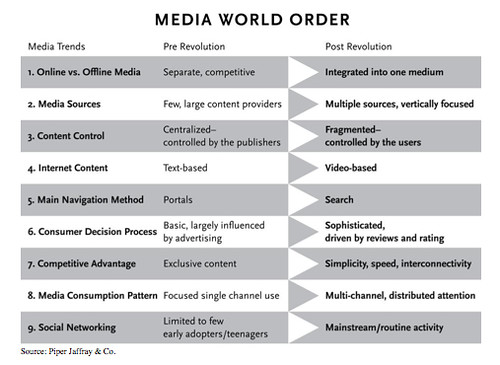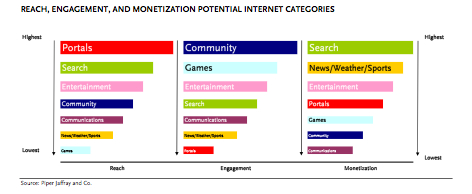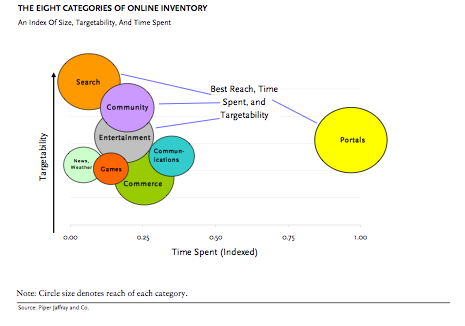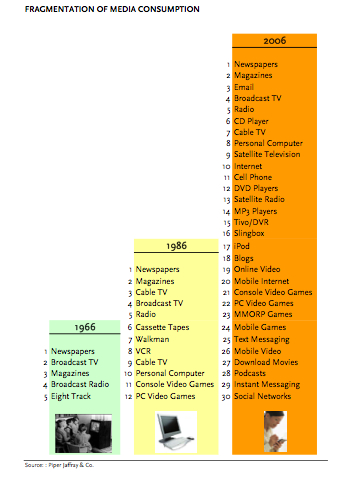US investment bank Piper Jaffray put out some of the smartest publicly available thinking about the internet space at the moment: last week they issued a new detailed report called The User Revolution: The New Advertising Ecosystem and The Rise of the Internet as a Mass Medium. Piper Jaffray customers can get a copy from their representative, I am on their email list because of my long-term interest in this area.
Reading it at first, my initial reaction was that I thought that it was quite patronising, but then I realised that the document has to assume little to no knowledge because its main audience is going to be fund managers of all ilks.
The Piper Jaffray report has some great industry data points and articulates many of the key concepts that are shaping this market in an easy and articulate manner. In the accompanying industry note the technology analyst team pulled out those key points as an executive summary; some of which I expect to see being incorporated into PowerPoiint presentations at a meeting near you:
The User Revolution
The User Revolution – consumers taking control of content consumption and branding. User-generated content as well as user indent driven services (like Amazon, Last.fm and Yahoo! Music’s Launch radio stations).

Communitainment – The three areas that historically drove demand for internet services like Yahoo! and AOL of comunity, communication and entertainment are being directly addressed all at once by new services acting as an accelerant for for the market

The Golden Search – ’search as the new portal’. When I used to work at Yahoo! search was described as the front door to the web. A much quoted statistic was that over seven out of every ten internet sessions was started from a search enquiry. Piper Jaffray thinks that search will be increasingly used in branding campaigns (marketers really need to crack this as contextual and search adverts have encouraged brand disloyalty – Kelkoo’s whole business was built on the back of Google ads with pretty much zero brand marketing, and you have a generation of online marketers who use quantative data from search marketing without any regard to brand value, instead focusing purely on transactional data).
Video ads
Video ads will be the next thing – this is kind of counter-intuitive as ads have moved from banners and animation to text ads, but then services like YouTube facilitate in-programming ads a la television.

I found the following section of the report executive summary particularly pertinent, and as a PR consultant it is the concept that clients I have spoken to find the most difficult to grasp: The Revolution Is About Control. The uprising by the users is over control – control of the type of content users want, control of the place and time content is delivered., control of the advertisements that the users are willing to take, and control of the brands they want to create. Unlike most revolutions, where the masses revolt because of major hardship and grievance, the User Revolution was largely driven by the proliferation of media options, the emergence of the Internet, and the growing sophistication of consumers.
I find the last point of particular interest, particularly when I think of the adverts that run on UK television for products like the now defunct Courts Carpets or Cillit Bang – perhaps there isn’t that much wisdom in marketing.
And finally just a couple of the business risks that I through of interest:
- The loss of confidence by advertisers in the effiacy of online advertising and emerging business models.
- A decrease in efficacy of online advertising including display and search advertising
Media fragmentation
I particularly like how they show the fragmentation of media over the past 40 years! ![]()

More related content here.

